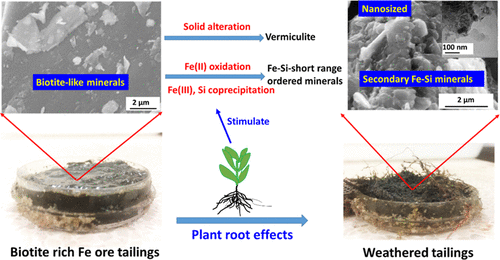当前位置:
X-MOL 学术
›
ACS Earth Space Chem.
›
论文详情
Our official English website, www.x-mol.net, welcomes your feedback! (Note: you will need to create a separate account there.)
Rhizosphere Drives Biotite-Like Mineral Weathering and Secondary Fe–Si Mineral Formation in Fe Ore Tailings
ACS Earth and Space Chemistry ( IF 3.4 ) Pub Date : 2021-02-24 , DOI: 10.1021/acsearthspacechem.0c00331 Songlin Wu, Yunjia Liu, Gordon Southam, Lachlan M. Robertson, Jeremy Wykes, Qing Yi, Merinda Hall, Zhen Li, Qiang Sun, Narottam Saha, Ting-Shan Chan, Ying-Rui Lu, Longbin Huang
ACS Earth and Space Chemistry ( IF 3.4 ) Pub Date : 2021-02-24 , DOI: 10.1021/acsearthspacechem.0c00331 Songlin Wu, Yunjia Liu, Gordon Southam, Lachlan M. Robertson, Jeremy Wykes, Qing Yi, Merinda Hall, Zhen Li, Qiang Sun, Narottam Saha, Ting-Shan Chan, Ying-Rui Lu, Longbin Huang

|
Pioneer plants play an important role in eco-engineering Fe ore tailings into soil for sustainable mine site rehabilitation. However, root-driven mineral weathering and secondary mineral formation remain poorly understood in tailings, despite being prerequisites for aggregate formation and pedogenesis. The present study aimed at characterizing the direct role of plant roots in tailing mineral weathering and secondary mineral formation in a compartmented cultivation system. It was found that root activities accelerated the weathering of biotite-like minerals via Fe(II) oxidation coupled with Fe(III) and Si dissolution. Numerous nanosized Fe–Si short-range-ordered (SRO) minerals and vermiculite were neoformed in the tailings after root interactions, as revealed by various microspectroscopic analyses. The Fe–Si-SRO minerals may have resulted from co-precipitation of dissolved Fe(III) and Si on mineral surfaces under alkaline and circumneutral pH conditions. Among the three plant species, Sorghum spp. (Gramineae plant) root developed most extensively in the tailings, possibly leading to more efficient mineral weathering and secondary mineral formation than Atriplex amnicola (halophyte plant) and Acacia chisholmii (leguminous plant). Overall, the study has elucidated the rhizosphere effects on tailing mineral (biotite dominant) weathering and secondary Fe–Si mineral formation, justifying pioneer plant roles in eco-engineering Fe ore tailings into soil.
中文翻译:

根际驱动铁矿石尾矿中类似黑云母的矿物风化和次生的Fe-Si矿物形成
先锋工厂在将铁尾矿生态工程化到土壤中以实现可持续矿场恢复中发挥着重要作用。然而,尽管是骨料形成和成岩作用的先决条件,但在尾矿中对根源驱动的矿物风化和次生矿物形成的了解仍然很少。本研究旨在表征植物根在隔间栽培系统中尾矿矿物风化和次生矿物形成中的直接作用。研究发现,根系活动通过Fe(II)氧化与Fe(III)和Si的溶解作用加快了黑云母状矿物的风化作用。各种显微分析表明,根相互作用后,尾矿中新形成了许多纳米级的Fe-Si短程(SRO)矿物和ver石。Fe-Si-SRO矿物可能是由于在碱性和周围pH值条件下矿物表面上溶解的Fe(III)和Si的共沉淀而产生的。在这三种植物中,高粱属 (禾本科植物)根系在尾矿中发育最广泛,可能导致比Atriplex amnicola(盐生植物)和Acacia chisholmii(豆科植物)更有效的矿物风化和次生矿物形成。总体而言,该研究阐明了根际对尾矿矿物(黑云母为主)的风化和次生Fe-Si矿物形成的影响,证明了先锋植物在生态工程中将铁尾矿转化为土壤的作用。
更新日期:2021-03-18
中文翻译:

根际驱动铁矿石尾矿中类似黑云母的矿物风化和次生的Fe-Si矿物形成
先锋工厂在将铁尾矿生态工程化到土壤中以实现可持续矿场恢复中发挥着重要作用。然而,尽管是骨料形成和成岩作用的先决条件,但在尾矿中对根源驱动的矿物风化和次生矿物形成的了解仍然很少。本研究旨在表征植物根在隔间栽培系统中尾矿矿物风化和次生矿物形成中的直接作用。研究发现,根系活动通过Fe(II)氧化与Fe(III)和Si的溶解作用加快了黑云母状矿物的风化作用。各种显微分析表明,根相互作用后,尾矿中新形成了许多纳米级的Fe-Si短程(SRO)矿物和ver石。Fe-Si-SRO矿物可能是由于在碱性和周围pH值条件下矿物表面上溶解的Fe(III)和Si的共沉淀而产生的。在这三种植物中,高粱属 (禾本科植物)根系在尾矿中发育最广泛,可能导致比Atriplex amnicola(盐生植物)和Acacia chisholmii(豆科植物)更有效的矿物风化和次生矿物形成。总体而言,该研究阐明了根际对尾矿矿物(黑云母为主)的风化和次生Fe-Si矿物形成的影响,证明了先锋植物在生态工程中将铁尾矿转化为土壤的作用。



























 京公网安备 11010802027423号
京公网安备 11010802027423号